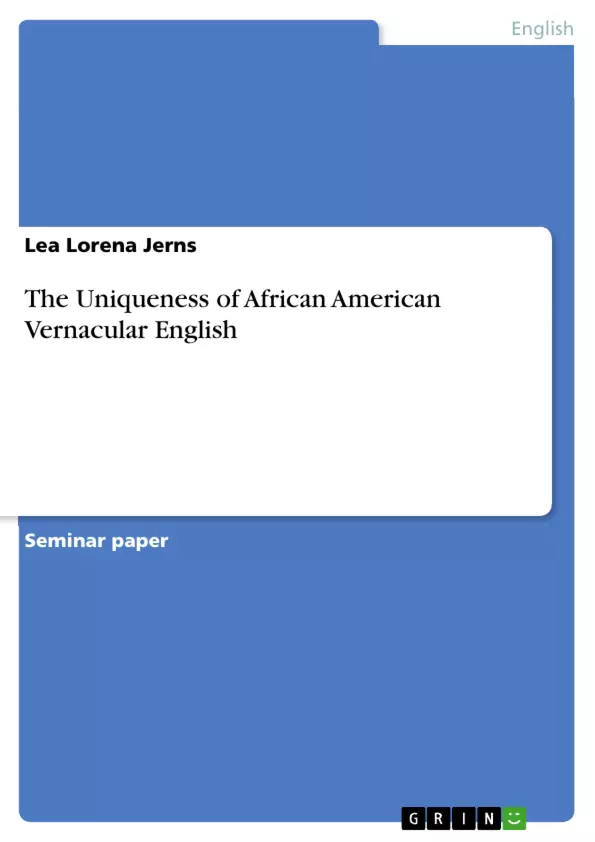"The language, only the language...it is the thing that black people love so much – the saying of words, holding them on the tongue, experimenting with them, playing with them. It’s a love, a passion. Its function is like a preacher’s: to make you stand up out of your seat, make you lose yourself and ear yourself. The worst of all possible things that could happen is to lose that language. There are certain things I cannot say with-out recourse to my language."
With these words Toni Morrison, an American professor and novelist, probably expressed exactly what many African American people felt and still feel. In her statement she refers to the so-called “African American Vernacular English”, abbreviated AAVE, which is “a variant of English spoken mostly by black people in the United States.” (Jokinen 2008: 1) It is also known as “African American English”, “Black English Vernacular”, “Black Vernacular Eng-lish”, “Black Vernacular”, “Black English” or “Ebonics”. It is important to point out that not all African Americans inevitably speak this ethnolect and that there are also people with a non-African American background who nonetheless may speak it. (cf. Patrick 2007: 1) Fur-thermore, it is hard to define who actually speaks AAVE as some speakers may only use some features, e.g. vocabulary or grammatical aspects, of this variant. (cf. Jokinen 2008: 1)
AAVE is a variant of English that you can see and hear every day – it is present in the Internet and in many songs and that makes it so interesting to find out more about it and to get a better understanding of AAVE. In this paper, I will focus on different aspects. I will start dealing with the question “Where does AAVE come from?” under point two and will continue with a brief overview of some basic grammatical features of AAVE in point three. Under point four, I will present and discuss a concrete example of a text, in which AAVE plays an important role, namely in the short story The Gilded Six-Bits of Zora Neale Hurston, written in 1933. Afterwards, under point five, I am going to talk about AAVE in Rap and HipHop songs as there can be found a considerable number of this kind of music all around the world and, under point 6, I will deal with the controversial question whether AAVE should be taught in schools or not. Finally, in the conclusion of my paper, I would like to let the uniqueness of AAVE and the importance of recognizing...
Inhaltsverzeichnis (Table of Contents)
- Introduction
- The origins of African American Vernacular English
- Features of African American Vernacular English
- Phonological features
- Negation
- Tense, mood and aspect
- Vocabulary
- African American Vernacular English using the example of Zora Neale Hurston's short story The Gilded Six-Bits
- African American Vernacular English in Rap and Hip Hop songs
- African American Vernacular English as language of education?
- Conclusion
Zielsetzung und Themenschwerpunkte (Objectives and Key Themes)
This paper aims to explore the origins and key features of African American Vernacular English (AAVE), examining its history, grammatical characteristics, and its role in different social and cultural contexts. It explores the use of AAVE in literature, music, and education, offering insights into its significance and potential influence on American society.
- The origins of AAVE and the different perspectives on its development
- The linguistic characteristics of AAVE, including its phonology, grammar, and vocabulary
- The role of AAVE in literature, specifically in the short story "The Gilded Six-Bits" by Zora Neale Hurston
- The presence of AAVE in contemporary music, particularly in rap and hip hop
- The debate surrounding the use of AAVE in education and its implications for language acquisition and cultural identity
Zusammenfassung der Kapitel (Chapter Summaries)
The first chapter introduces the subject of AAVE, highlighting its importance in African American culture and its broader social and cultural significance. The second chapter examines the origins of AAVE, discussing various theories including the Afrocentric, Eurocentric, and Creolist views.
The third chapter delves into specific features of AAVE, analyzing its phonology, negation patterns, tense and aspect systems, and vocabulary. The fourth chapter presents a concrete example of AAVE usage in Zora Neale Hurston's "The Gilded Six-Bits," demonstrating its linguistic and stylistic characteristics within a literary context.
The fifth chapter explores the prominent role of AAVE in contemporary music, particularly in rap and hip hop, examining its impact on musical language and cultural expression. The sixth chapter delves into the controversial question of whether AAVE should be taught in schools, examining the potential benefits and challenges of its inclusion in educational settings.
Schlüsselwörter (Keywords)
African American Vernacular English (AAVE), ethnolect, origins, pidgin language, creolization, phonology, negation, tense, aspect, vocabulary, literature, Zora Neale Hurston, "The Gilded Six-Bits," rap, hip hop, education, language acquisition, cultural identity.
- Quote paper
- Lea Lorena Jerns (Author), 2014, The Uniqueness of African American Vernacular English, Munich, GRIN Verlag, https://www.grin.com/document/274166



